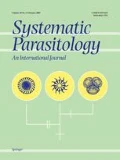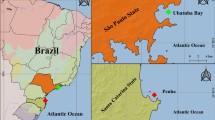Abstract
A revision of Platybothrium Linton, 1890 is presented, based on available type and voucher material, as well as extensive new collections from elasmobranchs belonging to the Carcharhinidae (requiem sharks) and Sphyrnidae (hammerhead sharks). All 10 nominal Platybothrium species are treated or redescribed herein. Four of these 10 nominal species, in addition to one former member of Dicranobothrium Euzet, 1953, are considered valid members of Platybothrium. Five new Platybothrium species are described: P. angelbahiense n. sp. ex Carcharhinus leucas, P. coshtaprum n. sp. ex C. plumbeus, P. jondoeorum n. sp. ex Negaprion acutidens and C. melanopterus, P. kirstenae n. sp. ex C. obscurus, and P. tantulum n. sp. ex Sphyrna lewini and S. zygaena. Sixty-three morphological characters were employed in cladistic analyses of nine Platybothrium species and five outgroup species. Coding and analysis strategies were varied to assess the effects of coding inapplicable characters as missing or as a separate character state, and of excluding characters for which data are missing in more than 10% of the taxa. The analysis in which inapplicable characters were coded as a separate character state and no characters were excluded produced the best-supported and most conservative estimate of the interrelationships of Platybothrium spp. Platybothrium appears to be a monophyletic assemblage, with the most basal species being P. spinulifera Southwell, 1912. The group of species possessing an accessory piece between the hooks forms a clade within the genus. Species lacking an accessory piece, which had previously been placed in Dicranobothrium Euzet, 1953, do not appear to be each other's closest relatives; thus, Dicranobothrium is considered a synonym of Platybothrium. An examination of host associations indicated that Platybothrium species are broadly distributed among, and entirely restricted to, carcharhinid and sphyrnid shark species. Most Platybothrium species exhibit oioxenous host-specificity, with all but two species each parasitising only a single host species. In several host species, multiple Platybothrium congeners parasitise the same host individual, a phenomenon not previously reported for Platybothrium.
Similar content being viewed by others
References
Baer, J.G. & Euzet, L. (1962) Revision critique des cestodes tétraphyllides décrits par T. Southwell (1re partie). Bulletin de la Société Neuchâteloise des Sciences Naturelles, 85, 143–172.
Baylis, H.A. (1950) A review of the species of Dinobothrium (Cestoda), with a description of a new species. Parasitology, 40, 96–104.
Caira, J.N. (1985a) An emendation of the generic diagnosis of Phoreiobothrium Linton, 1889 (Tetraphyllidea: Onchobothriidae) with a detailed description of bothridia and hooks. Canadian Journal of Zoology, 63, 1199–1206.
Caira, J.N. (1985b) Calliobothrium evani sp. n. (Tetraphyllidea: Onchobothriidae) from the Gulf of California, with a redescription of the hooks of C. lintoni and a proposal for onchobothriid hook terminology. Proceedings of the Helminthological Society of Washington, 52, 166–174.
Caira, J.N. & Jensen, K. (2001) An investigation of the coevolutionary relationships between onchobothriid tapeworms and their elasmobranch hosts. International Journal for Parasitology, 31, 960–975.
Caira, J.N., Healy, C.J. & Swanson, J. (1996) A new species of Phoreiobothrium (Cestoidea: Tetraphyllidea) from the great hammerhead shark Sphyrna mokarran and its implications for the evolution of the onchobothriid scolex. Journal of Parasitology, 82, 458–462.
Caira, J.N., Jensen, K. & Healy, C.J. (1999) On the phylogenetic relationships among tetraphyllidean, lecanicephalidean and diphyllidean tapeworm genera. Systematic Parasitology, 42, 77–151.
Caira, J.N., Jensen, K. & Healy, C.J. (2001) Interrelationships among tetraphyllidean and lecanicephalidean cestodes. In: Littlewood, D.T.J. & Bray, R.A. (Eds) Interrelationships of the Platyhelminthes. London: Taylor & Francis, pp. 135–158.
Carvajal, J. (1974) Records of cestodes from Chilean sharks. Journal of Parasitology, 60, 29–34.
Cohn, L. (1902) Zur Kenntnis des Genus Wageneria Monticelli und anderer Cestoden. Zentralblatt für Bakteriologie und Parasitenkunde, 33, 53–60.
Compagno, L.J.V. (1984) FAO Species Catalogue, Vol. 4, Part 2: Sharks of the world. An annotated and illustrated catalogue of shark species known to date. FAO Fisheries Synopsis No. 125, Rome: United Nations Development Programme/Food and Agriculture Organisation of the United Nations, 655 pp.
Compagno, L.J.V. (1988) Sharks of the Order Carcharhiniformes. Princeton: Princeton University Press, 486 pp.
Curran, S. & Caira, J.N. (1995) Attachment site specificity and the tapeworm assemblage in the spiral intestine of the blue shark (Prionace glauca). Journal of Parasitology, 81, 149–157.
Deshmukh, R.A., Shinde, G.B. & Jadhav, B.V. (1977) On a new species of the genus Platybothrium Linton 1899 (Cestoda: Onchobothriidae) from a marine fish at Veraval, west coast of India. (Abstract) In: Fotedar, D.N. (Ed.) All-India Symposium on Helminthology. Srinaquar, Kashmir: Normal Press, p. 9.
Diesing, K.M. (1863) Revision der Cephalocotyleen. Abtheilung: Paramecotyleen Sitzungsberichten der Akademie der Wissenschaften Wien Mathematische-Naturwissenschaften Klasse Abtheilung I, 48, 200–345.
Eschmeyer, W.N. (1998) Catalogue of fishes. Volume 1. San Francisco: California Academy of Sciences, 958 pp.
Euzet, L. (1952) Sur deux cestodes tétraphyllides. Bulletin de la Société Neuchâteloise des Sciences Naturelles, 75(3e Série), 169–178.
Euzet, L. (1953) Dicranobothrium, un nouveau genre de cestode tétraphyllide, parasite de sélaciens. Bulletin de la Société Neuchâteloise des Sciences Naturelles, 76(3e Série), 87–91.
Euzet, L. (1959) Recherches sur les cestodes tétraphyllides des sélaciens des côtes de France. Docteur és Sciences Naturelles, Université de Montpellier, 263 pp.
Euzet, L. (1994) Order Tetraphyllidea Carus, 1863. In: Khalil, L.F., Jones, A. & Bray, R.A. (Eds.) Keys to the cestode parasites of vertebrates. Wallingford: CAB International, pp. 149–194.
Faliex, E., Tyler, G. & Euzet, L. (2000) A new species of Ditrachybothridium (Cestoda: Diphyllidea) from Galeus sp. (Selachii, Scyliorhynidae) from the South Pacific Ocean, with a revision of the diagnosis of the order, family, and genus and notes on descriptive terminology of microtriches. Journal of Parasitology, 86, 1078–1084.
Forey, P.L., Humphries, C.J., Kitching, I.L., Scotland, R.W., Siebert, D.J. & Williams, D.M. (1992) Cladistics: A practical course in systematics. Oxford: Oxford University Press, 191 pp.
Fuhrmann, O. (1931) Dritte Klasse des Cladus Platyhelminthes. Cestoidea. In: Kukenthal, W. (Ed.) Handbuch der Zoologie. Berlin and Leipzig: Kukenthal & Krumback, 1930-1931, 2; pp. 141–416.
Hawkins, J.A., Hughes, C.E. & Scotland, R.W. (1997) Primary homology assessment, characters and character states. Cladistics, 13, 275–283.
Healy, C.J., Scholz, T. & Caira, J.N. (2001) Erudituncus n. gen. (Tetraphyllidea: Onchobothriidae) with a redescription of E. musteli (Yamaguti, 1952) n. comb. and comments on its hook homologies. Journal of Parasitology, 87, 833–837.
Henderson, A.C., Flannery, K. & Dunne, J. (2002) Parasites of the blue shark (Prionace glauca L.), in the North-East Atlantic Ocean. Journal of Natural History, 36, 1995–2004.
Hornell, J. & Nayudu, M.R. (1924) A contribution to the life-history of the Indian sardine with notes on the plankton of the Malabar coast. Madras Fisheries Bulletin, 17, 129–197.
Joyeux, C. & Baer, J.G. (1936) Cestodes. Faune de France, 30, 1–613.
Joyeux, C. & Baer, J.G. (1961) Classe de cestodaires. In: Grassé, P.P. (Ed.) Traité de Zoologie, Anatomie-Systématique Biologie, 4, 347–560.
Kodedová, I., Dolezel, D., Broucková, M., Jirku, M., Hypsa, V., Lukes, J. & Scholz, T. (2000) On the phylogenetic positions of the Caryophyllidea, Pseudophyllidea and Proteocephalidea (Eucestoda) inferred from 18S rRNA. International Journal for Parasitology, 30, 1109–1113.
Lee, D.-C. & Bryant, H.N. (1999) A reconsideration of the coding of inapplicable characters: assuptions and problems. Cladistics, 15, 373–378.
Linton, E. (1890) 9. Notes on Entozoa of marine fishes of New England, with descriptions of several new species. Part II. Report of the United States Commissioner of Fisheries (1887), Washington D.C., 15, 718–899.
Linton, E. (1900) Fish parasites collected at Woods Hole in 1898. United States Fish Commission Bulletin for 1899, 14, 267–304.
Linton, E. (1901) Parasites of fishes of the Woods Hole region. United States Fish Commission Bulletin for 1899, 19, 405–492.
Linton, E. (1924) Notes on cestode parasites of sharks and skates. Proceedings of the United States National Museum, 64, 1–114.
Littlewood, D.T.J. & Olson, P.D. (2001) Small subunit rDNA and the Platyhelminthes: Signal, noise, conflict and compromise. In: Littlewood, D.T.J. & Bray, R.A. (Eds.) Interrelationships of the Platyhelminthes. London: Taylor & Francis, pp. 262–278.
Maddison, D.R. & Maddison, W.P. (2000) MacClade 4: Analysis of phylogeny and character evolution. Version 4.0. Sunderland, Massachusetts: Sinauer Associates.
Mola, P. (1903) Su di un Cestodi del Carcharodon rondeletti Müller et Henle. Archivio Zoologico Italiano, Napoli, 1, 345–346.
Mola, P. (1907) Due nova forme di Tetraphyllidae. Bolletino Societas Adriatico Sciencias Naturales, 24, 1–16.
Nasin, C.S., Caira, J.N. & Euzet, L. (1997) Analysis of Calliobothrium (Tetraphyllidea: Onchobothriidae) with descriptions of three new species and erection of a new genus. Journal of Parasitology, 83, 714–733.
Örley, L. (1885) A czapaknak es rajaknak belfergei. Termeszetrajzi Feuzetek, 9, 97–126.
Olson, P.D. & Caira, J.N. (1999) Evolution of the major lineages of tapeworms (Platyhelminthes: Cestoidea) inferred from 18S ribosomal DNA and elongation factor-1?. Journal of Parasitology, 85, 1134–1159.
Olson, P.D., Ruhnke, T.R., Sanney, J. & Hudson, T. (1999) Evidence for host-specific clades of tetraphyllidean tapeworms (Platyhelminthes: Eucestoda) revealed by analysis of 18S ssrDNA. International Journal for Parasitology, 29, 1465–1476.
Olson, P.D., Littlewood, D.T.J., Bray, R.A. & Mariaux, J. (2001) Interrelationships and evolution of the tapeworms (Platyhelminthes: Cestoda). Molecular Phylogenetics and Evolution, 19, 443–467.
Perrenoud, W. (1931) Recherches anatomiques et histologiques sur quelques cestodes de selaciens. Revue de Suisse de Zoologie, 38, 518–525.
Potter, C.C. (1937) A new cestode from a shark (Hypoprion brevirostis Poey). Proceedings of the Helminthological Society of Washington, 4, 70–72.
Rego, A.A. & Mayer, M.T. (1976) Ocorrência de duas espécies de tetrafilídeos em tubarão da costa Brasileira e considerações sobre os gêneros Cylindrophorous, Platybothrium e Phoreiobothrium (Cestoda, Tetraphyllidea). Revista Brasileira de Biologia, 36, 321–328.
Ride, W.D.L., Cogger, H.G., Dupuis, C., Kraus, O., Minelli, A., Thompson F.C. & Tubbs, P.K. (1999) International Code of Zoological Nomenclature. Fourth edition. London: The International Trust for Zoological Nomenclature, The Natural History Museum, 306 pp.
Riser, N.W. (1955) Studies on cestode parasites of sharks and skates. Journal of the Tennessee Academy of Science, 30, 265–311.
Schmidt, G.D. (1986) CRC Handbook of tapeworm identification. Boca Raton: CRC Press Inc., 675 pp.
Shirai, S. (1996) Phylogenetic interrelationships of neoselachians (Chondrichthyes: Euselachii). In: Stiassny, M.L.J., Parenti, L.R. & Johnson, G.D. (Eds) Interrelationships of fishes. San Diego: Academic Press, pp. 9–34.
Shuler, R.H. (1938) Some cestodes of fish from Tortugas, Florida. Journal of Parasitology, 24, 57–63.
Southwell, T. (1912) A description of ten new species of cestode parasites from marine fishes of Ceylon, with notes on other cestodes from the same region. Ceylon Marine Biological Report 1, 259–278.
Southwell, T. (1925) A monograph on the Tetraphyllidea with notes on related cestodes. Memoirs of the Liverpool School of Tropical Medicine, 2(New Series), 1–368.
Strong, E.E. & Lipscomb, D. (1999) Character coding and inapplicable data. Cladistics, 15, 363–371.
Swofford, D.L. (1993) PAUP: Phylogenetic analysis using parsimony. Version 3.1. Illinois Natural History Survey, 257 pp.
Threlfall, W. (1969) Some parasites from elasmobranchs in New-foundland. Journal of the Fisheries Research Board of Canada, 26, 805–811.
Wagener, G.R. (1854) Die Entwicklung der Cestoden. Nova Acta Academia Naturae Curiosorum, 24(Supplement), 1–91.
Wang, Y. & Yang, W. (2001) One new species of Platybothrium from marine fishes in Xiamen, Fujian, China. Journal of Oceanography in Taiwan Strait, 20, 200–204.
Wardle, R.A. & McLeod, J.A. (1952) The zoology of tapeworms. Minneapolis: University of Minnesota Press, 780 pp.
Watson, D.E. & Thorson, T.B. (1976) Helminths from elasmobranchs in Central American fresh waters. In: Thorson, T.B. (Ed.) Investigations of the ichthyofauna of Nicaraguan lakes. Lincoln, Nebraska: University of Nebraska, pp. 629–640.
Yamaguti, S. (1952) Studies on the helminth fauna of Japan. Part 49. Cestodes of fishes II. Acta Medicinae Okayama, 8, 1–76.
Yamaguti, S. (1959) Systema helminthum. Vol. II. The cestodes of vertebrates. New York: Interscience Publishers, 860 pp.
Author information
Authors and Affiliations
Rights and permissions
About this article
Cite this article
Healy, C.J. A revision of Platybothrium Linton, 1890 (Tetraphyllidea: Onchobothriidae), with a phylogenetic analysis and comments on host-parasite associations. Syst Parasitol 56, 85–139 (2003). https://doi.org/10.1023/A:1026135528505
Issue Date:
DOI: https://doi.org/10.1023/A:1026135528505




